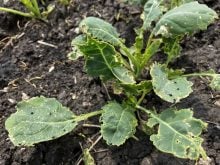Fungi present of the greatest challenges to plant health. Wheat is at risk of septoria blotch caused by zymoseptoria tritici, corn is at risk of the corn smut fungus called ustilago maydis, and the rice blast fungus, magnaporthe oryzae, can ravage rice crops.
Crops can be protected with fungicides but continued use can lead to chemical resistance in the fungi.
A team of scientists at the University of Exeter in the United Kingdom recently identified a new chemical compound that offers hope for a new class of antifungal products. The compound appears not only to be more effective at killing fungus, but also at alerting the plant’s defence system against the pathogen, is not toxic to plants and will be far less toxic to aquatic organisms than currently used fungicides.
Read Also

Growing garlic by the thousands in Manitoba
Grower holds a planting party day every fall as a crowd gathers to help put 28,000 plants, and sometimes more, into theground
As well, the compound can trigger cell death, a cellular suicide in which the fungus literally self-destructs.
The compound so far is known only by its technical name C18-SMe2+.
“We needed to find a process that could interfere with the fungi so that they die,” said Gero Steinberg, professor of cell biology. “There are so many things in a cell that are important to the fungi but we needed to find something that would be the end of story for the organism. That process is mitochondria.”
Mitochondria in fungi form the cellular powerhouse needed for all the essential processes in the pathogen. It is fueled by the molecule adenosine triphosphate (ATP), often known as the molecular currency that stores and transports chemical energy within cells.
“You don’t get anything done in the cell without ATP,” said Steinberg. “It is a molecule that is needed to literally do everything. It is like gas for cars. It is fed into the mitochondria respiration chain in order to create energy. When you target the respiration chain, you target the flow of the electrons, the core of the engine. If this is not working, the cell is no longer able to produce ATP and everything stops.”
The research team identified mono-alkyl chain lipophilic cations (MALCs) as potent inhibitors of the activity of fungal mitochondria. Once they make their way into the mitochondria, MALCs cut down the cellular energy supply, which eventually kills the pathogen.
Researchers have one newly synthesized MALC named C18-SMe2+ that was highly successful in generating aggressive molecules that target life-essential fungal proteins and initiating self-destruction.
“Due to the superior performance of C18-SMe2+ as an anti-fungal compound, this compound has the potential to become a useful new fungicide,” said Steinberg. “C18-SMe2+ combines numerous advantages. It is more environmentally friendly than many existing fungicides. Most exciting is the finding that it attacks the mitochondria respiration chain in multiple ways, which triggers an internal “suicide” pathway. In particular, this effect on the process of programmed cell death is interesting, because initiating this is a point of no return. Often, when you apply a fungicide, rain is able to wash it out, which bears the risk that the pathogen cell can recover. But when the programmed cell death pathway is activated, the fungus will self-destruct.
“We found out that only this one molecule works in this way, and it was pure luck that we found it. But the molecular details of how C18-SMe2+ acts on mitochondria are not yet known.”
Steinberg said that C18-SMe2+ is of relatively low toxicity. It is eight times less poisonous to water fleas compared to chemically similar fungicides currently in field use.
C18-SMe2+ also shows lower toxicity to human cells, is not mutagenic, meaning it will not induce mutations, and shows no toxicity to plants. At the same time, it ramps up the plant’s defence mechanisms.
However, an important question is whether fungi can build up resistance to this new chemistry.
“This compound targets several existential processes, thereby inhibiting ATP production and initiating the “suicide” program,” he said. “This multiple mode of action makes it unlikely that the fungal pathogen can develop resistance against C18-SMe2+. Future studies are planned to investigate the risk of resistance development and also prove that C18-SMe2+ is useful to control fungal pathogens in the field.
Steinberg said the university is open to collaborations and needs partners to develop the new chemistry to its potential.
Steinberg wrote in the report, “We are in an arms-race against crop pathogens to secure our future food security. The rapid development of resistance in market leader chemistries makes the identification of new fungicides a priority. More sustainable fungicides, combining lower risk of resistance development and a safe toxicity profile to humans and the environment are the current drivers in crop protection research.”
The research paper was published in the scientific journal Nature Communications.
















